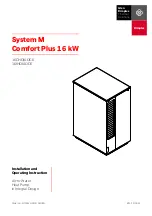
30
In accordance with EN 12056-4, pumping stations must be maintained and repaired to ensure the proper disposal of
wastewater and to detect and eliminate malfunctions at an early stage.
The proper functioning of pumping stations must be checked by the user once a month by observing at least two
operating cycles.
The inside of the tank should be checked from time to time and deposits, especially around the level sensor, should be
removed, if necessary.
In accordance with EN 12056-4, maintenance of the pumping station must be performed by qualified staff. The
following intervals should not be exceeded:
• 3 months for pumping stations for industrial use;
• 6 months for pumping stations for small communities;
• 1 year for domestic pumping stations.
8.3 Maintenance contract
As with any technical, high-performance equipment, SANIFOS
®
pumping stations must be maintained to ensure a
sustainable level of performance. We recommend you take out a maintenance contract with a qualified company to
carry out regular inspection and maintenance work. For more information, please contact us.
9. CHECKLIST FOR COMMISSIONING/
INSPECTION (1) AND MAINTENANCE (2)
9.1 Checklist for commissioning SANIFOS pumping stations
®
• Check that the system is switched off.
• Unscrew the safety screw then the cover.
• Check that the tank is level.
• Check that there is no deformation, crushing or cracking of the tank.
• Check the internal cleanliness of the tank (no soil, no sand…).
• Check the tightness of the valve connections.
• Check that the discharge diameter is appropriate for the installation.
• Check that the installation location of the SANIFOS station
®
respects a slope of gravity discharge of the effluents to the
tank (and that the FEA makes it possible to have the cover of the tank at the level of the ground).
• Check the tightness of the clamps of the inlet and outlet connections.
• Check the presence of the tank ventilation (diameter 75 for SANIFOS
®
110, 110 P, 250, 500 and diameter
100 for SANIFOS
®
1300). Air must flow in both directions.
• Check the tightness of the electrical casing (underground tank) or the glands (floor-standing tank).
• Check that the voltage and frequency of the power supply correspond to those indicated on the rating plate of the
appliance.
• Check the size of the power supply cable (3G 1.5 mm²) / (5G2.5 mm²) for three-phase versions.
• Check that the power supply circuit is earthed and protected by a 30 mA differential circuit breaker.
• Check that the power cable is not damaged.
NOTE:
Setting up a maintenance plan avoids costly repairs, minimizes maintenance work and achieves correct
and reliable operation.
Clogged ventilation port.
Risk that the pumping station will not work!
➜
Check the ventilation piping regularly. The passage should never be blocked.





































